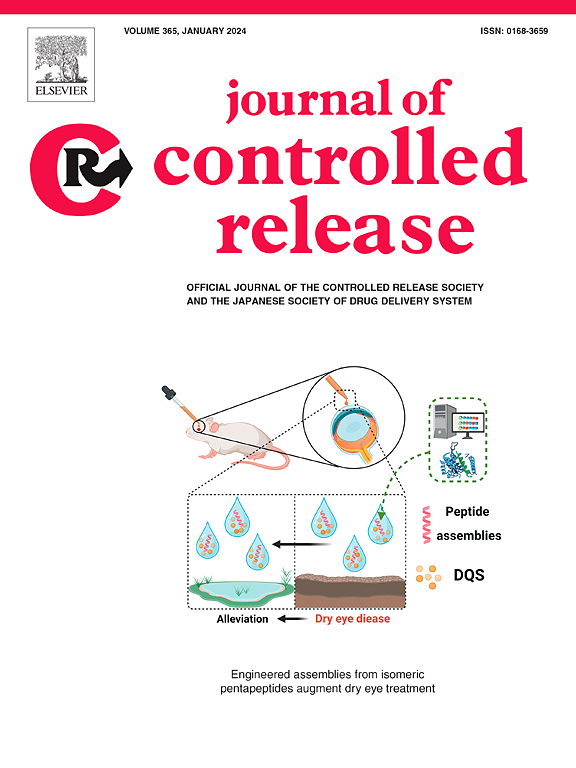自加压口服胶囊经胃肠道高速递送生物制剂
IF 10.5
1区 医学
Q1 CHEMISTRY, MULTIDISCIPLINARY
引用次数: 0
摘要
生物药物已经改变了医学,但由于需要注射给药而受到限制。为了实现生物制剂的口服递送,我们提出对流力作为克服胃肠道屏障的物理方法。我们设计了口服胶囊,在GIT中自加压,在特定压力(100-170 kPa)下机械失效,并以足够的速度喷出冻干药物以穿透粘膜屏障。这种口服的、自加压的气雾剂(OSPRAE)是由一个包被的明胶胶囊制成的,胶囊中充满了产生压力的起泡赋形剂(碳酸氢钠、柠檬酸)和生物可降解的聚合物腔(聚乳酸)中的药物。在体外初步优化后,OSPRAE允许胰岛素递送到手术暴露的肠粘膜,其药代动力学和药效学与大鼠皮下注射相似,尽管生物利用度较低。组织学分析显示,只有肠上皮的浅表损伤,高度局限于显微镜下的冲击区域。未来的研究应该将OSPRAE口服给较大的动物,并最终用于人类。OSPRAE胶囊提供了一种利用对流力增加生物制剂通过肠道粘膜的递送的新方法,这与先前涉及化学渗透增强剂和机电设备的方法形成了对比。本文章由计算机程序翻译,如有差异,请以英文原文为准。


High-velocity delivery of biologics via the gastrointestinal tract by self-pressurized oral capsules
Biologic drugs have transformed medicine, but are limited by their need for administration by injection. To enable oral delivery of biologics, we propose convective force as a physical method to overcome the barriers of the gastrointestinal tract (GIT). We designed oral capsules that self-pressurize in the GIT, mechanically fail at a specific pressure (100–170 kPa), and eject lyophilized drug with sufficient velocity to penetrate the mucosal barrier. This oral, self-pressurized aerosol (OSPRAE) was produced by a coated gelatin capsule filled with pressure-generating effervescent excipients (sodium bicarbonate, citric acid) and drug in a biodegradable polymer chamber (poly(lactic acid)). After initial optimization in vitro, OSPRAE allowed for insulin delivery to surgically exposed intestinal mucosa in vivo with similar pharmacokinetics and pharmacodynamics to subcutaneous injection in rats, despite lower bioavailability. Histological analysis showed only superficial damage to the intestinal epithelium that was highly localized to the microscopic area of impact. Future studies should administer OSPRAE orally to larger animals and, ultimately, to humans. The OSPRAE capsule offers a novel method to increase delivery of biologics across the intestinal mucosa using convective force, which contrasts with prior approaches involving chemical penetration enhancers and electromechanical devices.
求助全文
通过发布文献求助,成功后即可免费获取论文全文。
去求助
来源期刊

Journal of Controlled Release
医学-化学综合
CiteScore
18.50
自引率
5.60%
发文量
700
审稿时长
39 days
期刊介绍:
The Journal of Controlled Release (JCR) proudly serves as the Official Journal of the Controlled Release Society and the Japan Society of Drug Delivery System.
Dedicated to the broad field of delivery science and technology, JCR publishes high-quality research articles covering drug delivery systems and all facets of formulations. This includes the physicochemical and biological properties of drugs, design and characterization of dosage forms, release mechanisms, in vivo testing, and formulation research and development across pharmaceutical, diagnostic, agricultural, environmental, cosmetic, and food industries.
Priority is given to manuscripts that contribute to the fundamental understanding of principles or demonstrate the advantages of novel technologies in terms of safety and efficacy over current clinical standards. JCR strives to be a leading platform for advancements in delivery science and technology.
 求助内容:
求助内容: 应助结果提醒方式:
应助结果提醒方式:


